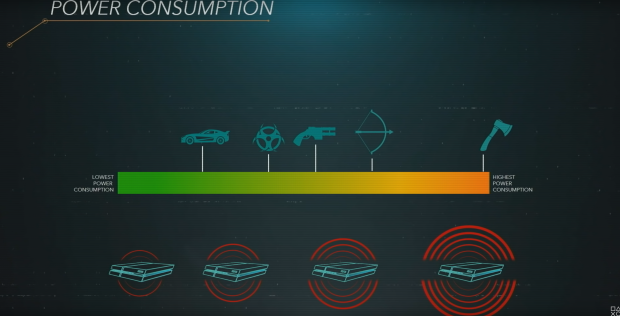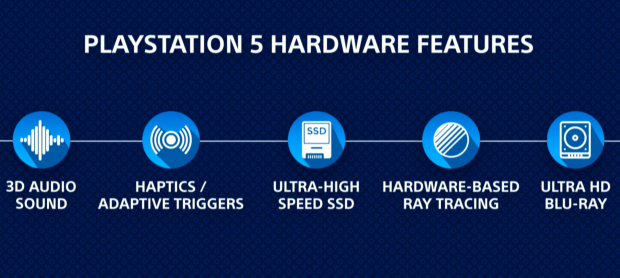A bit ago we reported on some unverified rumors that the PS5 is overheating due to big cooling issues, and that's the reason why Sony hasn't shown the console. But as many have suggested, this is extremely unlikely. The PlayStation 5 was built from the ground up with heat management in mind. There's a lot to cover here, so be forewarned: This is a big article.

Sony's PlayStation 5 should have a robust cooling solution that not only adequately manages heat, but also reduces fan noise. The reality is the PS5 has been built around proper heat dissipation from the get-go. The PS5's powerful 8-core Zen 2 CPU and 10.3TFLOP Navi 2X GPU SoC can belt out some serious performance, but they also require increased electrical power to hit their respective thresholds.
And with more power draw comes more heat. Sony recognized this issue from the start and literally re-designed how the CPU and GPU operate in the PlayStation 5 to ensure optimal heat management.
In his recent tech talk, PS5 architect Mark Cerny discusses how this new method works. Hardware-wise, the PS5 will have a much bigger fan and power supply this time around, and that's to be expected because the 7nm chip needs much more power to hit peak performance (for comparison, the Xbox Series X has a huge 130mm and vapor chamber cooler, complete with a 300W PSU). The key to the next-gen system's cooling is actually tied to the PS5's variable CPU and GPU frequency, and the console's always-on boost mode actually enables high-end cooling instead of hindering it.
Everything depends on the variable frequencies and how the console's drawn power now dictates workloads.
Cerny explains how previous generations' cooling solutions were made around guesswork. Sony had to guess at theoretical max performance levels in specific games and build a fan and PSU around that. The result is the PS4's jet-engine sound. This solution worked, but was inelegant. The PS4's SoC ran at a constant locked frequency and drew more power as needed, leading to lots of inefficient thermals. So the more a demanding a game was, the higher the power draw, and the more the fan roared up.
"There's a lot to be said for faster, assuming you can handle the resultant power and heat issues, which frankly we haven't always done the best job at," Cerny said.
"Part of the reason for that is, historically, our processor CPU and GPU frequencies relied on some heavy-duty guesswork with regards to how much electrical power games will consume, and how much heat will be produced as a result inside of the console.
"Power consumption varies a lot from game to game. When I play God of War on my PS4 Pro, I know the power consumption is high just by the fan noise. But power isn't simply about engine quality. It's about the minutae of what's being displayed, and how. It's counter-intuitive, but processing dense geometry typically consumes less power than processing simple geometry. Which is why I suspect why Horizon: Zero Dawn's map screen with its low triangle count makes my PS4 Pro heat up so much.
"Our process on previous consoles has been try to guess what the maximum power consumption during the entire console lifetime might be. Which is to say, the worst-case scene in the worst-case game and prepare a cooling solution that we think will be quiet at that power level.
"If we get it right, then the noise is minimal. If we get it wrong, the console will be quite loud for the higher-power games. There's even a chance it might overheat and shut down if we mis-estimate power to that length."
(Continued below)

Cerny acknowledges the PS5's Zen 2 CPU presented a tough challenge insofar as cooling. The CPU is quite powerful (especially when compared to the older Jaguar-based CPUs of old) but it's also more power hungry. Cerny says to enable the full brunt of the Zen 2 CPU and give developers maximum power, Sony had to "noticably increase" the system's fan. This development was planned out from the very beginning, and rightly so.
"PlayStation 5 is especially challenging because the CPU supports 256-bit native instructions that consume a lot of power. These are great here and there, but presumably only minimally used...or are they?
"If we plan for major 256-bit instruction usage, we need to set the CPU clock substantially lower or noticably increase the size of the power supply and fan.
"So, after much discussion, we decided to go with a very different direction on PlayStation 5," Cerny said in the presentation.
The PlayStation 5's SoC was created with thermals in mind. The CPU and GPU selection, their frequencies, the RAM and even the SSD--everything was paired up, scaled, and customized to reduce and manage heat as efficiently as possible.
Cerny explains that the PS5's hardware design is revolutionary for PlayStation console development. The power supply runs at a almost-locked power rate to enable constant adequate cooling, whereas the CPU and GPU frequencies fluctuate based on workloads. The result could be smooth, consistent cooling even under the most demanding 4K 60FPS or 1080p 120FPS with ray-traced visual workloads.
"We built a GPU with 36CUs. Mind you, RDNA 2 CUs are large. Each has 62% more transistors than the CUs we were using on PlayStation 4. So if we compare transistor counts, 36 RDNA CUs equates to roughly 58 PS4 CUs. It is a fairly sizable GPU.
"Then we went with a variable frequency strategy with PlayStation 5. Which is to say we continuously run the GPU and CPU in boost mode. We supply a generous amount of electrical power, and then increase the frequency of GPU and CPU until they reach the capabilities of the system's cooling solution.
"It's a completely different paradigm. Rather than running constant frequency, and letting power vary based on the workload, we run at essentially constant power and let the frequency vary based on the workload."
(Continued below)

Finally, Cerny asserts that PlayStation fans will be pretty happy with the PS5's cooling array. And a full teardown of the console is coming soon, so keep an eye out for that.
The cooling solution will determine the console's final design, so we might see a vertical tower-like PlayStation 5 similar to the Xbox Series X's mini-ITX design.
"We then tackled the engineering challenge of a cost-effective and high-performance cooling solution designed for that specific power level. In some ways, it becomes a more simple problem because there are no more unknowns. There's no need to guess what the power consumption in a worst-case game might have.
"As for details of the cooling solution, we're saving them for our teardown. I think you'll be quite happy with what the engineering team came up with."
The PS5 will release in Holiday 2020, and it may cost $499.
Check below for more info on everything we know about the PlayStation 5 so far:
PlayStation 5 specs and details:
- Custom SoC with second-gen Navi GPU, Zen 2 CPU
- 8-Core, 16-thread Zen 2 CPU at 3.5GHz
- Navi 2X GPU with 36 CUs on RDNA 2 at 2.23GHz
- Ultra-fast 825GB SSD with up to 9GB/sec speeds
- Support for 4K 120 Hz TVs
- Ray-tracing enabled
- 8K output support (for gaming)
- Plays PS4 games, BC is on a title-to-title basis
- Separate games that ship on BD-XL Blu-ray discs
- New controller with extensive haptic and tactile feedback
PlayStation 5 Coverage:
- Sony's PS5 talk wasn't enough--for next-gen, seeing is believing
- Only PlayStation 5 next-gen exclusives will tap SSD's full potential
- PlayStation 5 may play thousands of PS4 games at launch
- PS5's boost mode is so powerful that some PS4 games can't handle it
- PS5 won't play PS1, PS2 or PS3 discs, 100 PS4 games supported at launch
- Understanding the PS5's SSD: A deep dive into next-gen storage tech
- PlayStation 5 won't use memory cards, supports third-party SSDs
- PlayStation 5 specs: 10TFLOPs Navi RDNA 2 2.23GHz GPU, 3.5GH Zen 2 CPU
- PlayStation 5 SSD speeds hit 9GB/sec with custom 12-channel controller
- PlayStation 5, Xbox Series X ray tracing is easily scalable for devs
- Report: PlayStation 5 Pro and base PlayStation 5 coming in 2020
- 60FPS on next-gen PlayStation 5, Xbox Series X 'is much easier'
- PlayStation 5 specs confirmed by Sony: 10TFLOPs Navi RDNA 2 2.23GHz GPU, 3.5GH Zen 2 CPU
- PlayStation 5 could use Samsung's 980 QVO SSDs
- PlayStation 5 is beating Xbox Series X in dev kit form right now
- Hardly any devs are making next-gen PS5, Xbox Series X games
- Sony working on new horror IP for PlayStation 5
- PlayStation 5 devkit UI possibly leaked
- Leaked PlayStation 5 concepts show weird X-shaped case
- Sony's first-party PS4 exclusives are coming to PC
- PlayStation 5's new DualShock 5 may be usable on PS4
- Sony skips E3 2020, has two major events planned for February
- Next-gen console exclusives will be few and far between through 2021
- PlayStation 5's biggest features have yet to be announced, Sony says
- PS4 has sold over 1 billion games and 106 million consoles
- PlayStation 5 backward compatibility should support every PS4 game
- Sony reveals the PlayStation 5...logo
- New trapezoidal PS5 render is an expensive accident waiting to happen
- A $399 PlayStation 5 will conquer next-gen
- PlayStation 5 to outsell Xbox Series X in 2020, analyst predicts
- PS5 may only enhance PS4 games, legacy PS1, PS2 and PS3 games unlikely
- PlayStation 5 prototype dev kit console gets V-shaped clean
- Sony: The future is coming at CES 2020
- PlayStation 5 GPU: 9.2 TFLOPs with 36 custom Navi compute units
- PlayStation 5 GPU emulates PS4, PS4 Pro with special modes
- PS5, Xbox Series X SSD may use software-defined flash to boost speeds
- PS5's SSD is 'exceptionally powerful,' may beat Xbox Series X speeds
- DualShock 5 renders show new trigger design, USB-C, ergonomic shell
- PlayStation 5 to support 8K gaming, Sony confirms
- New PlayStation 5 renders show off radical different design, again
- Leaked PlayStation 5 ad prices console at $1,000, is totally fake
- Sony seeks a new Head of Strategy for Worldwide Studios
- Leaked PlayStation 5 devkit photos show new DualShock controller
- PS5, Xbox Scarlett SSD may use Optane-like ReRAM to supercharge speeds
- NVIDIA G-Sync monitors to improve PlayStation 5 and Xbox Scarlett
- PlayStation 5: Everything We Know So Far
- PlayStation 5 confirmed to have 8C/16T Zen 2 CPU from AMD
- PS5, Project Scarlett may use Samsung's 6th gen V-NAND NVMe SSDs
- PS5 backward compatibility confirmed, will play PS4 games
- Sony's next-gen PlayStation 5 has 4K 120Hz output support
- PS5, Project Scarlett to hit over 10TFLOPs of power, sources say
- PS4 will be supported into 2022, to live alongside PS5
- Sony: ultra-high-speed SSD is 'the key' to next-gen PS5
- PS5 dev kit rumor: 'ultra-fast RAM', Navi GPU with 13 TFLOPs
- PlayStation 5 rumored to ship with 2TB of super-fast SSD for $499
- Insider: PlayStation 5 dev kit faster than Xbox Scarlett right now
- PS5 cartridges aren't real, patents are for Sony kids toys
- PS5's SSD may benefit PS4 games the most
- PS5 powered by Navi in 2020, AMD making Navi with Sony input
- Cloud-powered PlayStation controller may let you play free game demos
- Gran Turismo 7 is a PlayStation 5 launch title: launches Nov 20, 2020
- PS5 confirmed to support 8K video, ray tracing, all on Navi
- PlayStation 5 rumored to cost $499, launches November 20, 2020
- PlayStation game demos are coming back with Sony's ambitious new plan
- PS5 controller: Built-in mic, USB-C, no lightbar, ergonomic design
- PlayStation 5 concept video shows totally new design
- Sony solves PS5's biggest issue
- Sony: PS5 development going according to plan
- New Viking Assassin's Creed may be next-gen console launch game
- AMD working on 'secret sauce' for next-gen Xbox/PlayStation
- The first real photo of a PlayStation 5 dev kit appears
- Next-gen PS5/Xbox Scarlett open-world game: 'best real-time graphics'
- Sony restructures workforce to prepare for PS5
- PlayStation VR 2: built-in cameras, wireless, ready for PS5
- PS5 games will ship on 100GB Blu-ray BDXL discs
- PS5 and Xbox Scarlett will both handle ray tracing differently
- PlayStation 5 could feature AI-powered 'PlayStation Assist'
- Sony won't abandon singleplayer story-driven games on PS5
- PS5 rumor: GPU is nearly as powerful as RTX 2080, GPU clocked at 2GHz
- PlayStation 5 rumored to be unveiled on February 12, 2020
- Sony to raise PS5 cost thanks to U.S. tariffs


